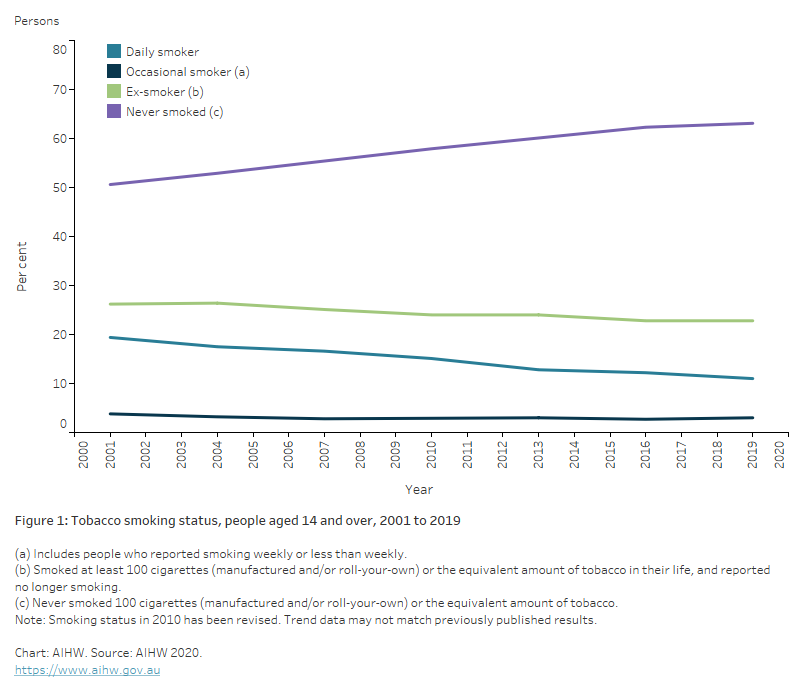Smoking
Tobacco smoking is the leading cause of preventable disease and death in Australia today. Smoking increases blood pressure, reduces blood oxygen levels and damages blood vessels, heightening the risk of plaques and clots.
People who smoke are at increased risk for the development and progression of chronic kidney disease – and that risk increases with greater lifetime exposure to smoking (Hallan and Orth 2011; Yacoub et al. 2010). Smoking contributes to negative outcomes for people with kidney transplants (Mercado and Jaimes 2007). Smoking also contributes to the development of other chronic diseases closely linked to chronic kidney disease, including cardiovascular disease and type 2 diabetes (Briganti et al. 2002).
Australia’s smoking rate has fallen over the past 40 years, largely attributable to public health strategies. However, the proportion of people continuing to smoke is still concerning, particularly in some population groups such as Aboriginal and Torres Strait Islander people, and people living in low socioeconomic areas (Greenhalgh et al. 2022).
In 2019, based on results from the National Drug Strategy Household Survey:
- 11% of people aged 14 and over smoked daily (males 12%, females 9.9%)
- men aged 40–49 had the highest proportion of current daily smokers (18%), while the highest proportion among women were aged 50–59 (15%)
- after adjusting for different population age structures over time, the proportion of males aged 14 and over who smoked daily fell from 21% in 2001 to 12% in 2019, with the proportion for females falling from 18% in 2001 to 9.9% in 2019 (Figure 1)
- daily smoking rates among males aged 15–24 fell from 21% in 2001 to 8.5% in 2019, and among females aged 15–24 from 20% in 2001 to 6.4% in 2019 (AIHW 2022).
Figure 1: Tobacco smoking status, people aged 14 and over, 2001 to 2019
The line chart shows the proportion of people smoking, by sex and smoking status between 2001 and 2019. Daily smokers fell from 19.4% in 2001 to 11.0% in 2019.

Variation between population groups
- 37% of Indigenous Australians aged 15 and over (200,400 people) smoked daily in 2018–19. After controlling for differences in the age structures of the populations, Indigenous Australians aged 15 and over were 3.0 times as likely to smoke daily as non-Indigenous Australians aged 15 and over (AIHW and NIAA 2022).
- 18% of people aged 14 and over living in the lowest socioeconomic areas smoked daily in 2019, compared with 5.0% living in the highest socioeconomic areas (AIHW 2022).
- 20% of people aged 14 and over living in Remote/very remote areas smoked daily in 2019, compared to 9.7% in Major cities (AIHW 2022).
AIHW (Australian Institute of Health and Welfare) (2022) Alcohol, tobacco & other drugs in Australia, AIHW, Australian Government, accessed 1 May 2022.
AIHW and NIAA (National Indigenous Australians Agency) (2022) Aboriginal and Torres Strait Islander Health Performance Framework summary report 2020, Measure 2.15 – Tobacco use, AIHW, Australian Government, accessed 31 May 2022.
Briganti EM, Branley P, Chadban SJ, Shaw JE, McNeil JJ, Welborn TA and Atkins RC (2002) Smoking is associated with renal impairment and proteinuria in the normal population: the AusDiab kidney study, American Journal of Kidney Diseases, 40:704–712, doi: 10.1053/ajkd.2002.35677.
Greenhalgh EM, Scollo MM and Winstanley MH (2022) Tobacco in Australia: facts and issues, Cancer Council Victoria, Melbourne, accessed 8 April 2022.
Hallan SI and Orth SR (2011) Smoking is a risk factor in the progression to kidney failure, Kidney International, 80:516–523, doi: 10.1038/ki.2011.157.
Mercado C and Jaimes EA (2007) Cigarette smoking as a risk factor for atherosclerosis and renal disease: novel pathogenic insights, Current Hypertension Reports, 9:66–72, doi: 10.1007/s11906-007-0012-8.
Yacoub R, Habib H, Lahdo A, Radwan AA, Varjabedian L, Atalla G, Aki NK, Aldakheel S, Alahdab S and Albitar S (2010) Association between smoking and chronic kidney disease: a case control study, BMC Public Health, 10:731, doi: 10.1186/1471-2458-10-731.


